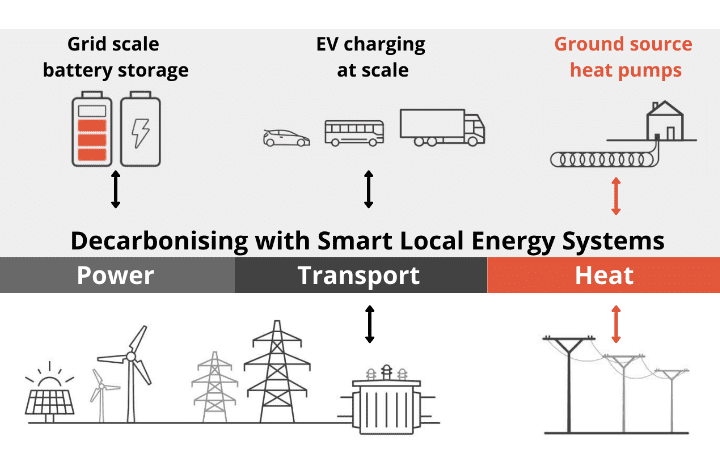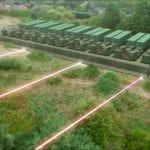Discover highlights of Kensa’s groundbreaking webinar!
This webinar took an exclusive look into the revolutionary project that is encompassing low-carbon heat, transport and power. Kensa Contracting and the Energy Superhub Oxford (ESO) consortium gave insight into the real-life model for large-scale decarbonisation – and showcased the smart technologies expected to combat 10,000 tonnes of CO2 emissions per year.
Decarbonisation of heating: balancing the grid
ESO is what the future of heating and decarbonisation of the grid will look like. The ground-breaking project will feature electric vehicle charging, battery energy storage and ground source heat pumps. Tim Rose, Programme Manager of Energy Superhub Oxford at Pivot Power, explained the battery element of the project, as Pivot Power is supplying the largest hybrid battery ever deployed.
This webinar highlighted the endless, low-carbon possibilities of smart local energy systems. Viewers also found out how the clever integration of smart controls, time-of-use tariffs and heat optimisation software in every home is set to future-proof the project and form a blueprint for smart cities to come.
Climate Emergency Response in Action
In January 2019, Oxford City Council declared a Climate Emergency Declaration – ESO is a direct response. Councillor, Tom Hayes, of Oxford City Council addressed the bigger, net-zero picture of the project, and how ESO will pave the way for Oxford’s large-scale decarbonisation of power, heat and transport.
A first-look virtual tour: Blackbird Leys
Views went behind the scenes at ESO’s pilot heating phase with Stonewater, where 60 homes are being retrofitted with ground source heat pumps and smart controls. They took a virtual tour of the site in Blackbird Leys with host, Dr. Matthew Trewhella, Managing Director of Kensa Contracting – and learnt how these renewable technologies will tackle fuel poverty and stamp out high-cost heating bills for residents. The webinar also demonstrated how the project is supporting decarbonisation aims from Adam Masters, Stonewater’s Environmental Sustainability Manager.
Pilot heating phase in Blackbird Leys – Watch the virtual tour:
Energy Superhub Oxford Q&As
What’s the average cost per property for the 60 Stonewater properties to provide the shared ground loop arrays, with individual heat pumps in each property?
The standard price of this project was just over £850,000 to Stonewater. So that’s a property average of just over £14,200. But because this was part of the Energy Superhub Oxford project and there’s Innovate UK funding available for certain parts of the heating installation then we were able to provide a discount or grant funding effectively to Stonewater housing association. For this specific project because it was the first one so they were able to get £3,000 per property of grant funding so that was £180,000 overall. The actual net cost to Stonewater for the project was just over £670,000, that’s just over £11,000 per property.
Why GSHP rather than ASHP – which is easier to install & has lower capital expenditure costs?
GSHP is easier to install once the ground array is installed. Overall capital costs are higher with ground source – mostly because of the boreholes. You will see the amount of engineering that goes into boreholes on the site tour. The running costs will be lower – because the source temperature is warmer. The heat pump will last longer – because it is kept in the airing cupboard rather than the garden. The ground array lasts more than 100 years so we think that initial higher capital costs are more than repaid in the long term.
How practical is it to install such a system in a neighbourhood where all the properties are owned privately?
It’s definitely a more challenging sector of the market and one of the attractions with working with social housing providers is talking to one decision maker about a range of properties on a single site. The need to tackle the domestic sector, the privately owned sector, is obviously there. A large proportion of the homes sit within the private sector and finding the tactics to tackle those is going to be really key.
From a ground source heat pump point of view, we very much have to see it as a strategic street-by-street rollout of decarbonisation. The way we view that probably happening is using either social housing or local authority owned estates as an anchor load and designing schemes to suit those areas. Then once we can develop a core volume then actually develop a commercial process whereby we can go to neighbouring neighbourhoods and make the offer to extend the scheme out to the privately owned properties.
So, there’s definitely a desire to go down that route and I think that models will emerge that will allow a long-term funding to come in and fund the infrastructure and then use either subsidy or the homeowner benefit or the running cost benefit to provide a payback to the resident and allow them to connect to the scheme. So, it’s definitely a challenging sector but I think there is a view to how we can we can transition to that. The other big challenge is that the scale that we have to get to first, to make it cost effective, we’ve got to make some real inroads into scaling up the rollout just in general to reduce costs to make it more viable for that type of scheme.
What’s the expected lifespan of the ground loop & the heat pumps? What maintenance regime is expected & would any repairs need to be via Kensa?
Ground loop: >100 years, Heat pump: 20-25 years. No required maintenance but inspections every 1-5 years are recommended. Mostly to ensure the other components connected to the heat pump (radiators, controls, pumps etc.) are working correctly. Repairs to the heat pump itself are rare and are normally carried out by Kensa but could be via any F-Gas qualified engineer.
Who maintains & repairs the heat pumps in a shared ground loop? Do customers own the heat pump?
In this specific project because Stonewater are the landlords and they own the properties then they will retain ownership of the heat pumps as well. The long-term maintenance of these systems will be carried out by Stonewater’s in-house or preferred maintenance contractor. Kensa has already provided training to those contractors for the previous systems that we’ve installed and we’ll continue to provide training to those contractors to make sure that they understand the system. The systems themselves are relatively easy to maintain. The ground source heat pump system is just a boiler effectively, but without the requirement to carry out gas safety checks on an annual basis. So, all you’re really left to do is check that the heating circulation pumps are working and that the rooms are getting up to temperature. So, there’s not actually a lot to do in terms of the service checks. For this specific retrofit project Stonewater maintains ownership and will carry out the long-term maintenance.
If you look at a development of new builds where some of them may be owned by the landlord like Stonewater, and some may be privately owned, then there can be different models. I guess it’s likely in those scenarios that the private householders would then take ownership of the heat pump themselves because it would be inside their property. In much the same way that a gas boiler is inside the property. Then the maintenance of the heat pump itself would become the responsibility of the homeowner, the responsibility for the ground array would then sit with the organisation that actually owns the ground array. So, in that sense it could be the housing association who owns the ground array for the whole site, it could be that the developer retains ownership, it could be that a management company is introduced which often is the case on many networks where there’s other communal facilities needing to be shared and looked after. In that scenario then that maintenance company would look after the ground array but the private homeowners would look after their individual pumps.
Would you consider using the ground source loop array for ‘sheltered’ type complexes?
Kensa Contracting has done work across a range of different types of sheltered accommodations. The very first scheme that we did for Stonewater going back two/three years ago was an estate of sheltered bungalows out in a rural estate in Hereford. But we also have done a number of sheltered blocks of flats, low rise flats, generally and using exactly the same approach of shared ground loops all connected to individual heat pumps within the dwelling. As far as the heat pump is concerned it’s really no different, what tends to happen with the sheltered complexes is that we will gather them together in slightly larger clusters. So we may have four or five boreholes serving 15-20 properties in a block just because it’s easier to get the pipework from the ground array outside and then distribute out to the heat pumps within the inside of the building. Probably the majority of social housing that we’ve done has actually been in sheltered blocks.
What’s the smallest size external garden/space you could drill a borehole in?
The drill rig itself, when it’s all set up, requires about nine meters by two meters to actually carry out the drilling. As you saw from the site tour video, they weren’t large gardens in the bungalows but the one advantage they had was that it was a communal garden set up, so we didn’t have to access via knocking down some walls and fences. It’s a relatively small space. Nine meters by two meters, perhaps sounds large but a lot of the projects that Kensa has carried out have been in small bungalows and small houses where there’s not a large amount of space. As long as you can get the borehole drill rig in, a lot of the other kit like the mudpuppies and the skips can all be kept off-site, away from the garden. So if you can drive a large transit van into the area you’ve probably got a fair chance of drilling the borehole.
Is it usually better to have a deep borehole rather than shallow loops of pipes for the ground source?
Nearly all of our work uses vertical closed-loop boreholes. It’s possible to get good results out of the horizontal ones but you just need a lot of space. It’s even more cost-effective to drill fewer boreholes and make them deeper as well. So even just going from a shallow collector to vertical ones making them deeper and doing fewer of them is more cost-effective.
What are the challenges to drill up to 300m deep?
We have a site where we’ve just done it for the first time, we typically drill 140 to 220m, the deepest previously was a project in Enfield about two years ago but we have just finished one in Yorkshire that’s 300 meters deep. Different geologies are going to be different answers but it’s bigger pumps, higher pressure machinery and you know a little bit of attention to detail on how we get that spoil back up to the surface.
What is the difference between a large battery connected and lots of batteries?
I mean there are different things. Obviously, they’re ultimately doing the same task, they’re storing energy at certain times and then exporting it at other times. The very large battery is providing further flexibility for the grid. So, as we put more renewable energy onto the grid, the grid needs flexibility, it needs to be able to stabilize itself. The grid does that through things like frequency response and will have other ways of managing the instability, which we can provide on this battery.
So, the big batteries are doing a couple of things really. One is that they’re trading, so they are taking in power when it’s cheap and exporting it when it’s at a high price. There’s revenue to be made on that. Also, they’re providing services to the national grid, such as we are, to help stabilize it and support more renewables coming on. So, when you get to the more private smaller domestic type units or for example in an office, the benefits you’re making there are really maximized if you can create your own energy. If you can use solar power or some other form of generation to generate that energy and store it yourself and then use it at times when otherwise you’d be importing at a higher price from the grid, you can really make benefits.
They both have their own place, the storage in domestic properties is going to be extremely valuable when we all have other ways of generating and storing energy ourselves and then using it at more expensive times. But this is a very different scale of thing that we’re doing here on the grid.
Is it the sense that other local authorities are keen to emulate Oxford’s lead? From experience on this project, what are the biggest obstacles they face in doing so?
Yes, Kensa is working with local authorities and social landlords across the country. The biggest obstacle is project finance and how to reconcile higher capital investment by the landlord with the lower bills going to the residents.
How much of an issue is simple awareness of what can be achieved?
Local Authorities face a challenge in trying to engage with key stakeholders across their regions and encourage them to decarbonise. This will take a significant amount of resource and planning. Increased awareness would be hugely beneficial and collaboration at a local level will help to increase awareness across sectors.
If a housing association wants to engage & get an idea of feasibility for their properties, how do they engage with the team & what are the expected timescales & milestones from enquiry to installations?
Kensa is delighted to speak to anyone that has a project in mind. We’ve got a sales team working across the whole of the UK. From Scotland all the way down to deepest darkest Cornwall.
Ideally, if you contact us with your contact details we’ll get in touch. Contact us with an idea of the project that you have in mind, whether it’s a retrofit project or a new-build project. What we do is a first pass feasibility so we’d take a look at the properties, try and make an assessment of the heat loads, make an assessment of the underlying geology so that we could estimate the number of boreholes and through that, we’ll be able to provide a budget cost for a complete system. All the way from the ground array, through to the heating system.
At that point, if that was of interest the next stage would be to discuss refining that estimate which usually happens by detailed design. The detailed design for a retrofit project would involve going to site and carrying out detailed surveys. We can do room-by-room heat loss calculations and really work out exactly where the boreholes are going to go and access for the drilling machine. For a new-build project, a lot of that work would be carried out as a desktop study and at that point, we’d agree on the scope of works, finalise the price, and then the next stage would be to move through procurement. Kensa is a member of many procurement contracts so we can do it that way if direct award is not possible and then finally delivering the project on-site.
The short answer is please send us your contact details and someone from the sales team will be happy to speak to you. You can call us on 0345 222 4328 or email us at info@kensacontractin
Keynote speakers included:
- Dr. Matthew Trewhella, Managing Director, Kensa Contracting
- Tom Hayes, Councillor, Oxford City Council
- Tim Rose, Programme Manager Energy Superhub Oxford, Pivot Power
- Adam Masters, Environmental Sustainability Manager, Stonewater
- David Broom, Commercial Director, Kensa Contracting
- Stuart Gadsden, Director of Sales, Kensa Contracting
- Lisa Treseder, Grants Specialist, Kensa Contracting

The ESO project consists of six consortium partners, who are joining forces to eliminate Oxford’s carbon emissions. The project is backed by the UKRI and made possible with funding from the ‘Prospering From an Energy Revolution’ (PFER) programme.
Want to watch the webinar recording?
If you would like to watch back this revolutionary webinar, please email events@thekensagroup.com and we’ll send a recording straight to your inbox!





